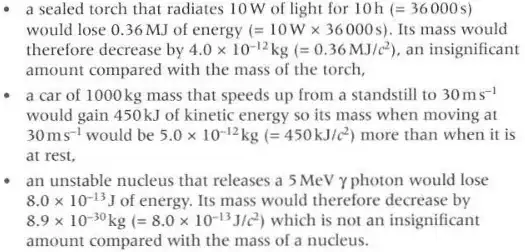Here are some examples from my textbook I will refer to, which I could not copy paste,
I understand that $E=mc^2$ applies fine for thinking about rest energy, but when the body is not at rest, would this be the change in fictitious "relativistic mass", or is this a legitimate phenomenon? In example 1, this would then be true, because the torch is at rest. In example 2, this would be fictitious because the movement of the car only affects its inertia, not its mass. In example 3 is where I would struggle to draw the line, because I would assume the nucleus to be at rest, but I think this would be used either way? Motion was not considered at all. I understand that the binding energy of a nucleus decreases some kind of mass than if the nucleons were considered separately, is this the true mass, or a "relativistic" mass? In other words, is the only reason the measured mass of a nucleus is different to its individual nucleons due to a relativistic effect?
